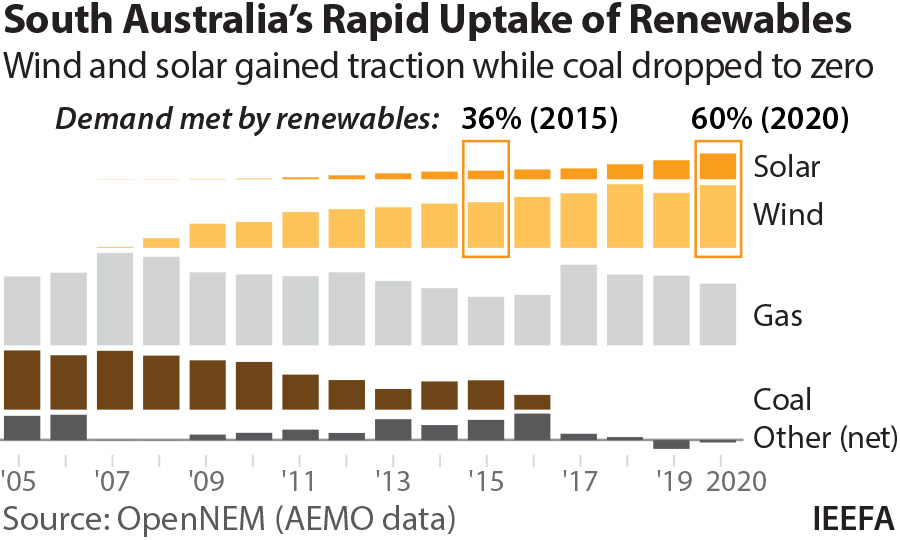IEEFA: Zero to 60% in 14 years – South Australia’s success in transitioning to renewables

3 June 2021 (IEEFA Australia): South Australia offers vital lessons for other jurisdictions transitioning from a fossil fuel-based electricity grid to a low emissions, high renewables grid, finds a new report by the Institute for Energy Economics and Financial Analysis (IEEFA).
Coal in South Australia was phased out in 2016
“The proportion of South Australia’s electricity demand met by large scale and small scale variable renewable energy generation grew from 0% to 60% in just 14 years,” says author Johanna Bowyer.
“Coal was phased out in 2016. Today the grid is dominated by wind and solar backed up by battery storage and interstate grid connectivity, with peaking gas being used as a temporary generation technology until South Australia moves to net 100% renewables.”
South Australia has the largest proportion of demand provided by rooftop solar of all states in Australia’s National Electricity Market, with 13% of grid demand provided by rooftop solar in 2020. 40% of homes have rooftop solar, making South Australia a global leader.
“But the records don’t stop there,” says co-author and DER specialist Dr Gabrielle Kuiper.
“South Australia has shown that 100% solar generation is possible during the daytime to meet users’ energy demands.”
100% solar generation is possible during the daytime
The fast initial uptake of renewables in South Australia was driven by market features including strong wind and solar resources, historically high residential electricity prices and historically high wholesale electricity prices, although wholesale prices have now dropped.
The increasing proportion of low-cost renewables in South Australia’s grid is driving down electricity prices. Wholesale electricity prices have dropped 65% in South Australia (2017 – 2021 year-to-date).
Government policies have been significant in facilitating the transition to a renewables dominated grid, including the national Renewable Energy Target and the South Australian rooftop solar feed-in tariff, and more recently the Home Battery Scheme.
South Australia is now expected to achieve its net 100% renewable energy target by 2025, five years ahead of schedule.
The South Australian government is also aiming to reach 500% renewables by 2050 and to become a renewable energy superpower, exporting surplus renewable energy to other states and internationally through green hydrogen and other low emissions products. This plan is driving new investment, jobs and economic growth in the state.
Government policies have been significant in facilitating the transition
On 31 May, a $2 billion interconnector between South Australia and New South Wales was granted final regulatory approval. This will be the largest interconnector built to date in the National Electricity Market, and is financially supported by the Clean Energy Finance Corporation’s $295 million hybrid security instrument. It is expected to unlock 1800MW of renewable energy generation in its path, create more than 2600 jobs in the region, and generate annual net energy savings of $100 per South Australian household and $60 per New South Wales household.
At present, South Australia’s electricity grid is connected with neighbouring state Victoria through two interconnectors, enabling South Australia to export low-cost renewable energy to Victoria and import energy back from Victoria when needed. The new interconnector will unlock further energy supply demand balancing capability between South Australia and New South Wales, benefitting both states. It is also expected to reduce the risk of South Australia being disconnected from the rest of the National Electricity Market, increasing grid security.
Other mechanisms are also being explored in South Australia to enhance grid security as the grid transitions away from synchronous, fossil fuel-based generators to asynchronous, renewable energy.
Batteries are a key technology solution being employed to help manage grid reliability and security. An early adopter, South Australia installed the largest battery energy storage system in the world at the time of commissioning (2017).
The Hornsdale battery can respond quickly to fluctuations in the grid to help maintain security. It has been a financial and technical success, saving consumers $150m in the first 2 years of operation and helping to maintain reliability and security in the grid.
Batteries are a key technology solution being employed
Furthermore, South Australia’s increasingly high penetration of rooftop solar is being managed with distribution network innovation.
“Productive innovations have included LV monitoring, transformer tap changes, and especially the development of dynamic operating envelopes (DOEs),” says Kuiper.
“South Australia’s network operator is now managing 40% rooftop solar household penetration using less than 1% of its regulated network revenue.”
Reliability standards have been met in South Australia since the transition to renewables began in force in 2007 (except for the year 2008/9 when there was an extreme heat event leading to both South Australia and Victoria not meeting reliability standards). This shows that maintaining reliability in a renewables dominated grid is possible.
Moving onwards to 500% renewables, South Australia will continue to set an example for other jurisdictions regarding how to manage large amounts of wind and solar in the grid.
“The transition to a zero-emissions, zero-inertia electricity grid with a comprehensive demand response regime and optimisation of both large scale and distributed energy resources has yet to be achieved anywhere in the world,” says Bowyer.
“South Australia has the potential to achieve this outcome within a decade with thoughtful planning and policy.”
South Australia provides 7 vital lessons for energy planners around the globe:
- Over 60% of annual demand can be provided by variable wind and solar and 100% in certain time periods
- Government policy and market features can drive high adoption of renewables
- Ambitious renewables plans can drive economic growth
- Wind and solar bring down wholesale electricity prices
- System reliability and security can be maintained in a high renewables grid
- Batteries (utility scale and behind the meter storage) can help maintain system reliability and security
- High penetrations of rooftop solar can be managed with distribution network innovation
Read the report: A Grid Dominated by Wind and Solar Is Possible. South Australia: A Window Into the Future
Media contact: Kate Finlayson ([email protected]) +61 418 254 237
Author contact: Johanna Bowyer ([email protected]) and Gabrielle Kuiper ([email protected])
About IEEFA: The Institute for Energy Economics and Financial Analysis (IEEFA) examines issues related to energy markets, trends, and policies. The Institute’s mission is to accelerate the transition to a diverse, sustainable and profitable energy economy. (www.ieefa.org)












